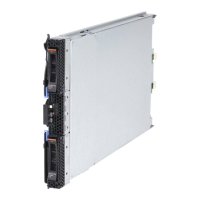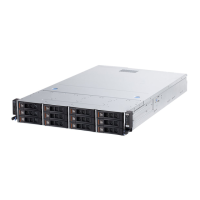128 IBM eX5 Implementation Guide
The MAX5 is connected to the x3690 X5 using two cables, connecting the QPI ports on the
server to two of the four QPI ports on the MAX5. The other two QPI ports of the MAX5 are
unused. The EXA ports are for future scaling capabilities.
Figure 4-11 shows architecturally how a single-node x3690 X5 is connected to a MAX5.
Figure 4-11 Connectivity of the x3690 X5 with a MAX5 memory expansion unit
As shown in Figure 4-11, the x3690 X5 attaches to the MAX5 using QPI links; you can see
that the eX5 chip set in the MAX5 simultaneously connects to both CPUs in the server.
One benefit of this connectivity is that the MAX5 is able to store a copy of the contents of the
last-level cache of all the CPUs in the server. Therefore, when a CPU requests content stored
in the cache of another CPU, the MAX5 not only has that same data stored in its own cache,
it is able to return the acknowledgement of the snoop
and the data to the requesting CPU in
the same transaction. For more information about QPI links and snooping, see 2.2.4,
“QuickPath Interconnect (QPI)” on page 18.
Connectivity of the MAX5 to the x3690 X5 is described in 4.6, “Scalability” on page 128.
For memory configuration information, see 4.8.3, “MAX5 memory” on page 136. For a
description of the power and fans, see 4.12, “Power supplies” on page 173.
4.6 Scalability
In this section, we describe how the x3690 X5 can be expanded to increase the number of
memory DIMMs.
Tip: The Xeon E6510 processor does not support the use of the MAX5.
QPI
links
16 DIMMs on
system planar
Memory tray
(16 DIMMs)
SMI
links
CPU
0
CPU
1
MAX5
EXA
QPI
QPI
EXA
EXA EXAQPI
x3690 X5
QPIQPI
QPI
QPI
32 DIMMs
on MAX5
External
QPI cables

